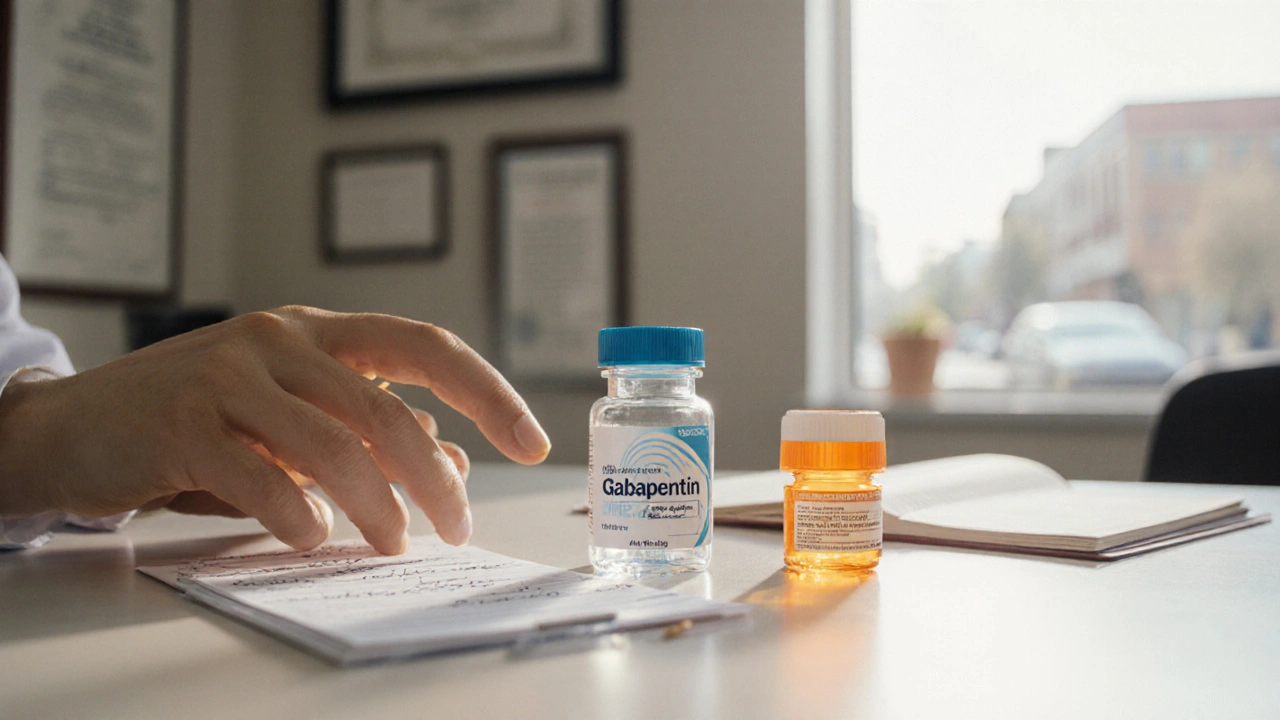Gabapentin vs Alternatives Comparison Tool
Select a drug to compare its features with gabapentin:
Click "Compare Selected Drug" to see detailed comparison
Gabapentin (Neurontin) is an anti‑seizure medication that also treats neuropathic pain. It works by modulating calcium channels in the nervous system.
Quick Take
- gabapentin is cheap and widely prescribed for nerve pain, but it can cause drowsiness and weight gain.
- Pregabalin (Lyrica) is more potent, works faster, but costs about three times more.
- Carbamazepine is an older option for trigeminal neuralgia; it needs blood‑level monitoring.
- Baclofen is a muscle‑relaxant useful when spasms accompany pain.
- Amitriptyline, duloxetine, and topiramate are off‑label choices that may help when first‑line drugs fail.
Why Compare Gabapentin with Other Drugs?
When a doctor writes a prescription for nerve‑pain relief, the choice isn’t always obvious. Gabapentin has been on the market for over 30years, yet newer agents promise better efficacy or fewer side‑effects. Understanding the trade‑offs helps you avoid a trial‑and‑error spiral that can waste months and money.
Key Criteria for a Fair Comparison
We’ll weigh each alternative against five practical factors that matter to most patients:
- Indications - What conditions is the drug officially approved for?
- Typical dosage range - How much you’ll actually take each day.
- Common side effects - What to expect in the short‑term.
- Cost (US average) - Price per month for a standard dose.
- Special considerations - Monitoring requirements, drug interactions, or contraindications.
Alternative #1: Pregabalin (Lyrica)
Pregabalin (brand name Lyrica) is a chemically‑related analogue of gabapentin. It received FDA approval for diabetic peripheral neuropathy, post‑herpetic neuralgia, fibromyalgia, and as an adjunct for partial seizures.
Typical dosing starts at 75mg twice‑daily and can climb to 300mg three times‑daily for severe pain. Side effects often include dizziness, peripheral edema, and a mild weight gain. Because it’s a newer patented drug, the average monthly cost sits around $250 without insurance, roughly three times the price of generic gabapentin.
Alternative #2: Carbamazepine
Carbamazepine is an older anticonvulsant that’s FDA‑approved for trigeminal neuralgia and focal seizures.
The usual dose for neuralgia ranges from 200mg to 400mg three times daily. It carries a higher risk of blood‑level fluctuations, so regular serum monitoring is mandatory. Common side effects include drowsiness, hyponatremia, and a rash that can progress to Stevens‑Johnson syndrome-a rare but serious concern. Generic carbamazepine costs roughly $30 per month, but the monitoring adds indirect expense.
Alternative #3: Baclofen
Baclofen is a GABA‑B receptor agonist primarily used as a muscle relaxant.
Although not approved for neuropathic pain, clinicians sometimes add it when painful muscle spasms coexist with nerve pain. Starting doses are 5mg three times daily, titrated up to 20mg three times daily. Side effects include sedation, weakness, and occasional low blood pressure. Monthly cost is about $15 for the generic version.

Alternative #4: Amitriptyline
Amitriptyline is a tricyclic antidepressant that has long been used off‑label for neuropathic pain and migraine prophylaxis.
Low‑dose regimens (10‑25mg at bedtime) often provide pain relief without major antidepressant effects. Typical side effects: dry mouth, constipation, and dizziness. Because it’s generic, the cost is under $5 per month, but it can cause significant daytime drowsiness, especially in older adults.
Alternative #5: Duloxetine
Duloxetine is an SNRI (serotonin‑norepinephrine reuptake inhibitor) FDA‑approved for diabetic peripheral neuropathy, fibromyalgia, and chronic musculoskeletal pain.
The standard dose is 60mg once daily. Common adverse events include nausea, sleep disturbances, and occasional hypertension. Brand‑name Cymbalta costs about $200 per month, though many insurers cover a generic version for $30‑$40.
Alternative #6: Topiramate
Topiramate is an anticonvulsant also used off‑label for migraine prevention and some neuropathic pain syndromes.
Typical dosing for pain starts at 25mg nightly, increasing to 100mg daily as tolerated. Side effects may include paresthesia, cognitive slowing, and weight loss. Generic topiramate runs about $15 per month.
Side‑by‑Side Comparison
| Drug | FDA‑Approved Indications | Typical Dose Range | Common Side Effects | Average Monthly Cost (US) | Special Considerations |
|---|---|---|---|---|---|
| Gabapentin | Post‑herpetic neuralgia, diabetic neuropathy, seizures | 300‑1800mg/day (divided) | Drowsiness, edema, weight gain | ~$10 (generic) | Renal dose adjustment needed |
| Pregabalin | Neuropathic pain, fibromyalgia, seizures | 75‑600mg/day | Dizziness, peripheral edema, weight gain | ~$250 (brand) | Higher abuse potential |
| Carbamazepine | Trigeminal neuralgia, focal seizures | 200‑1200mg/day | Rash, hyponatremia, drowsiness | ~$30 | Requires serum level monitoring |
| Baclofen | Muscle spasticity (off‑label pain) | 5‑60mg/day | Weakness, sedation, hypotension | ~$15 | Withdrawal seizures if stopped abruptly |
| Amitriptyline | Depression (off‑label pain) | 10‑25mg at bedtime | Dry mouth, constipation, dizziness | ~$5 | Contraindicated in heart disease |
| Duloxetine | Diabetic neuropathy, fibromyalgia, chronic pain | 60mg/day | Nausea, insomnia, hypertension | ~$30‑$200 | Avoid with MAO inhibitors |
| Topiramate | Seizures (off‑label pain) | 25‑200mg/day | Paresthesia, cognitive slowdown, weight loss | ~$15 | Kidney stones risk |
How to Pick the Right Option for You
Start with the condition you’re treating. If you have diabetic peripheral neuropathy and need a first‑line, low‑cost solution, gabapentin or duloxetine are sensible. For fibromyalgia, pregabalin or duloxetine usually outperform gabapentin.
Next, weigh side‑effect tolerance. Patients who can’t handle drowsiness may favor duloxetine (which is more activating) or topiramate (which often causes weight loss). Those with a history of kidney disease should avoid gabapentin and pregabalin because both are renally cleared.
Cost matters too. If insurance coverage is limited, amitriptyline or generic gabapentin keep the bill low. However, remember that cheap drugs can sometimes require higher doses, which may increase side‑effects.
Finally, check for drug‑interaction red flags. Carbamazepine is a strong enzyme inducer and can lower the effectiveness of many oral contraceptives and anticoagulants. Baclofen’s abrupt discontinuation can trigger seizures, so taper slowly.
Practical Tips to Maximize Benefit
- Start low, go slow: Begin with the lowest effective dose and increase weekly.
- Take at night if sedation is an issue-most of these drugs peak within 2‑4hours.
- Stay hydrated: Some (gabapentin, pregabalin) can cause peripheral edema.
- Track side effects in a journal; share the log with your prescriber.
- Ask about generic alternatives; they often provide the same efficacy at a fraction of the price.
Frequently Asked Questions
Can I switch from gabapentin to pregabalin without a wash‑out period?
Because both drugs act on the same calcium‑channel subunit, you can usually transition on the same day by stopping gabapentin and starting pregabalin at an equivalent dose, but always follow your doctor’s taper schedule to avoid rebound pain.
Is gabapentin safe during pregnancy?
Animal studies show no major teratogenic risk, but human data are limited. Most clinicians reserve gabapentin for pregnant patients only when the benefit outweighs potential unknown risks.
Why does gabapentin cause weight gain?
The drug can increase appetite and cause fluid retention. Pairing it with a balanced diet and regular exercise often mitigates the extra pounds.
What’s the biggest advantage of carbamazepine over gabapentin?
Carbamazepine works faster for trigeminal neuralgia and some shooting‑pain syndromes, where gabapentin may be too slow or insufficient.
Can I combine duloxetine with gabapentin?
Yes, the combination is common for mixed‑type pain (neuropathic + musculoskeletal). Monitor for increased dizziness and adjust doses as needed.









Write a comment
Your email address will be restricted to us